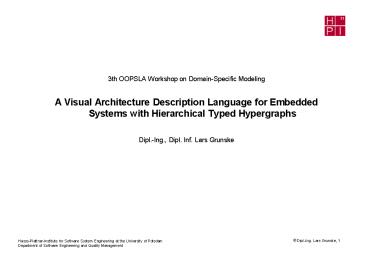3th OOPSLA Workshop on Domain-Specific Modeling - PowerPoint PPT Presentation
Title:
3th OOPSLA Workshop on Domain-Specific Modeling
Description:
A Visual Architecture ... for the behavior specification and architecture evaluation Graphical notation Practical realization The tool Balance ... – PowerPoint PPT presentation
Number of Views:54
Avg rating:3.0/5.0
Title: 3th OOPSLA Workshop on Domain-Specific Modeling
1
- 3th OOPSLA Workshop on Domain-Specific Modeling
- A Visual Architecture Description Language for
Embedded Systems with Hierarchical Typed
Hypergraphs - Dipl.-Ing., Dipl. Inf. Lars Grunske
2
Agenda
- Context
- Basic example
- The architecture description language COOL
- Software type system
- Hardware type system
- Extension for the behavior specification and
architecture evaluation - Graphical notation
- Practical realization
- The tool Balance
- Case study
- Conclusion
3
Context
- Goal Architecture specification of embedded
systems and quality improvement by architecture
transformation - Needs Transformation Operators that
- Improve the non-functional properties
- Preserve the functional properties
4
Basic Example (1)
- Level Crossing Control System
- Safety critical situation (hazard) Gates are
open and the arriving train gets the permission
to enter the level crossing section
5
Basic Example (2)
- Solution Increase the reliability of the gate
sensor by transforming the architecture
6
Basic Example (3)
- The transformation operator Homogeneous
Redundancy with Voting - Problem How can such a system be modelled in a
consistent way
7
The ADL COOL Focus
- Aim
- Model the architecture of software intensive
technical or embedded systems - Requirements
- Must be suitable to describe the sensors,
actuators, hardware components, and software
components. - Must provide a transformation formalism
- Must have a graphical notation
- Must have a formalism for hierarchical
decomposition - It must be possible
- to determine the non-functional properties (NFPs)
of the system such as safety, availability,
reliability, and temporal correctness - to check the fulfillment of the non-functional
requirements. - Must allow for the specification of the
functional behavior
8
The ADL COOL Concept
- Use of hierarchical typed hypergraphs
- Formal Specification Language
- Architecture transformation Application of
hypergraph transformation
9
The ADL COOL Software Aspects
10
The ADL COOL Hardware Aspects
11
Extending the Structure Specification for
Architecture Evaluation and Behaviour
Specification
- Behaviour specification
- Annotate architectural elements with interface
automata - Requirements Tracing
- Extension of the meta-classes hardware element
and software element with requirements references - Architecture Evaluation
- Extension of the meta-classes hardware element
and software element with evaluation models - Fault tree models
- Markov models
- Scheduling models
- Performance models
- Economical models
12
Graphical Notation
13
Practical Realization and the Tool Balance
14
Conclusion
- We have presented in these slides and the paper
- Basic concepts of architectural transformations
- Architecture description language COOL
- Visualization of this ADL
- Practical realization of the presented concepts
- Thanks for your attention
- Questions?































